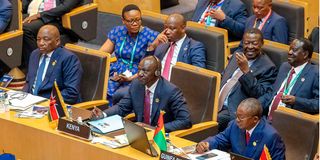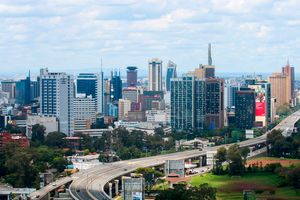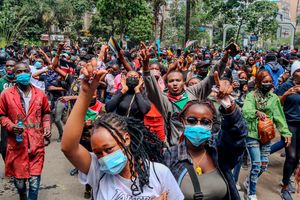
President William Ruto and his counterpart from Guinea Bissau Umaro Embalo (right) and Lesotho's Prime Minister Sam Matekane during the opening session of the 38th Ordinary Session of the Assembly of the African Union in Addis Ababa, Ethiopia.
Across Africa, the recent election of the African Union Commission (AUC) Chairperson was met with intense interest. The media spotlight focused on the three candidates vying for the role: Kenya’s Raila Odinga, Djibouti’s Mahamoud Ali Youssouf, and Madagascar’s Richard Randriamandrato. When Youssouf emerged victorious, questions lingered in my mind — What was the historical vision of the African union anyway? And are we still on message? And what is the relevance of the AU today in leveraging Africa’s competitiveness?
The African Union’s vision is deeply rooted in the courageous struggle for liberation, unity, and self-determination. It envisions a vibrant, prosperous, and peaceful Africa, standing proudly as a beacon of strength in the global community. As the world rapidly evolves, with nations from the US to the UK, the Netherlands, and beyond focusing on local priorities, the AU must lead by example and, too, demand transparency and accountability internally and in international deal making. By embracing its role as a champion of African resilience and progress, the AU can overcome the legacies of inequality, forging a brighter future where every African thrives.
Established in 2002, the AU evolved from the Organisation of African Unity (OAU), founded in 1963 in the aftermath of colonial rule. The OAU was born out of a grand vision — an integrated, independent Africa standing united on the global stage. Today we must again reimagine what the AU could be. We know that, in particular, the youth demographic represents an immense opportunity for economic and social transformation.
Daily, countless young Africans embark on perilous journeys across the Sahara and the Mediterranean, desperate to reach Europe. Many flee economic stagnation, political instability, and conflict, only to face even greater dangers at sea. The images of capsized boats off the coast of Lampedusa or overcrowded refugee camps in Calais are a stark indictment of leadership failures at home.
The African Youth Charter
The AU is also hampered by the weak enforcement mechanisms, chronic underfunding, and regional divisions. More than 40 per cent of AU member states fail to pay their annual contributions, leaving the organization dependent on external donors.
Yet despite all this, the dream of a unified Africa persists, and there are examples of bright moments when African leaders have come together united by the AU to root for Africa: a classic example is the African Continental Free Trade Area (AfCFTA), which creates a single market for goods and services across 48 ratified member states and is projected to boost intra-African trade from 18 per cent to 50 per cent by 2030.
It has also proven its effectiveness in responding appropriately, most recently in 2020 during the Covid-19 pandemic, under the leadership of Cyril Ramaphosa, he was instrumental in coordinating the continent’s efforts in managing the pandemic, establishing the Africa Covid-19 Resource Fund and launching the Africa Medical Supplies platform.
We also see how youth movements cross borders, languages and cultures on the continent through online activism, innovation, music, culture and sharing of ideas.
The AU has already started to make some strides in recognising the centrality of the youth. The African Youth Charter acknowledges that Africa’s greatest asset is its young population. Additionally, the newly elected AUC Chairperson has pledged to promote policies facilitating Africa’s transition to a green economy. If implemented effectively, this could create sustainable green jobs for millions of young Africans that are homegrown and we can start to address poverty and the climate trap we find ourselves in on the continent.
Force for real change
Another nod to the centrality of young Africans is the AU’s embrace of the Digital Economy of this demographic.
However, in complete contrast to these opened trade borders, the 2018 Protocol on Free Movement of Persons facilitating visa-free travel across the continent has been ratified by only four countries. It seems impossible to expect the free movement of goods and services when the free movement of people is such a challenge. In fact, African countries impose heavier visa restrictions on other Africans compared to travellers from outside the continent.
It is these types of barriers to progress and implementation of complementary and cohesive pan-African mechanisms that must be addressed. Prioritizing ease of travel - the proposed African Passport, creating opportunities to learn about diverse cultures and peoples across the continent with an African student exchange program between Ibadan, Cape Town, Cairo, Dar-Es-Salaam. The opportunity to work in different African countries, to represent their own countries as ambassadors - this was not unheard of in the 1960’s, so it can happen again.
The AU’s vision must be more than a legacy — it must be a force for real change. Africa’s future depends on bold leadership that drives economic integration, creating jobs and opportunities for our people especially our youth. This is our moment to shape a self-sufficient, thriving continent. This is an opportunity we cannot miss.
Wanjira Mathai is the MD for Africa & Global Partnerships at the World Resources Institute and Chair of the Wangari Maathai Foundation.







